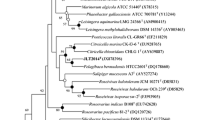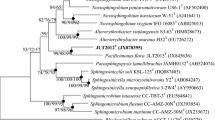Abstract
A Gram-negative, aerobic, motile by single polar flagellum, short rod-shaped bacterium was isolated from a deep-seawater sample of the Southeastern Pacific Ocean. Growth was found to occur at 10–40 °C, at pH 4.0–10.0 and in the presence of 0–9.0 % (w/v) NaCl. The phylogenetic tree based on 16S rRNA gene sequences showed that strain JLT2013T fell within a clade comprising species of the genus Parvularcula and formed a coherent cluster with Parvularcula lutaonensis CC-MMS-1T (neighbour-joining phylogenetic tree) or Parvularcula dongshanensis SH25T (maximum-likelihood and maximum-parsimony phylogenetic trees). Sequence similarity analyses based on 16S rRNA gene sequences revealed that strain JLT2013T shows high sequence similarity to P. lutaonensis CC-MMS-1T (96.7 %), P. dongshanensis SH25T (96.0 %) and Parvularcula bermudensis HTCC2503T (95.2 %). The major cellular fatty acids were identified as C12:0 (34.3 %), summed feature 8 (C18:1 ω7c and/or C18:1 ω6c) (10.9 %), C16:0 (10.0 %) and C17:1 ω6c (7.2 %). The polar lipids were found to include diphosphatidylglycerol, phosphatidylglycerol, three sphingoglycolipids and three unknown glycolipids. Strain JLT2013T was found to contain Q-10 as the predominant quinone. The DNA G+C content was determined to be 66.3 mol%. In the light of the phenotypic characteristics, chemotaxonomic features and phylogenetic evidence gathered in this study, strain JLT2013T (=LMG 27362T = CGMCC 1.12400T) should be classified as a novel species in the genus Parvularcula, for which the name Parvularcula oceanus sp. nov. is proposed.


Similar content being viewed by others
References
Arun AB, Chen WM, Lai WA, Chou JH, Rekha PD, Shen FT, Young CC (2009) Parvularcula lutaonensis sp. nov., a moderately thermotolerant marine bacterium isolated from a coastal hot spring. Int J Syst Evol Microbiol 59:998–1001
Cho JC, Giovannoni SJ (2003) Parvularcula bermudensis gen. nov., sp. nov., a marine bacterium that forms a deep branch in the α-Proteobacteria. Int J Syst Evol Microbiol 53:1031–1036
Chun J (1995) Computer assisted classification and identification of actinomycetes. PhD Thesis, University of Newcastle
Collins MD, Goodfellow M, Minnikin DE (1980) Fatty acid isoprenoid quinine and polar lipid composition in the classification of Curtobacterium and related taxa. J Gen Microbiol 118:29–37
Embley TM (1991) The linear PCR reaction: a simple and robust method for sequencing amplified rRNA genes. Lett Appl Microbiol 13:171–174
Fraser SL, Jorgensen JH (1997) Reappraisal of the antimicrobial susceptibilities of Chryseobacterium and Flavobacterium species and methods for reliable susceptibility testing. Antimicrob Agents Chemother 41:2738–2741
Gerhardt P, Murray RGE, Wood WA, Krieg NR (eds) (1994) Methods for general and molecular bacteriology. American Society for Microbiology, Washington, DC
Hall TA (1999) BioEdit: a user-friendly biological sequence alignment editor and analysis program for Windows 95/98/NT. Nucleic Acids Symp Ser 41:95–98
Kates M (1986) Techniques of lipidology: isolation, analysis and identification of lipids. In: Burdon RH, van Knippenberg PH (eds) Laboratory Techniques in Biochemistry and Molecular Biology. Elsevier, Amsterdam
Kim SB, Falconer C, Williams E, Goodfellow M (1998) Streptomyces thermocarboxydovorans sp. nov. and Streptomyces thermocarboxydus sp. nov., two moderately thermophilic carboxydotrophic species isolate from soil. Int J Syst Bacteriol 48:59–68
Kim OS, Cho YJ, Lee K, Yoon SH, Kim M, Na H, Park SC, Jeon YS, Lee JH, Yi H, Won S, Chun J (2012) Introducing EzTaxon-e: a prokaryotic 16S rRNA Gene sequence database with phylotypes that represent uncultured species. Int J Syst Evol Microbiol 62:716–721
Marmur J (1961) A procedure for the isolation of deoxyribonucleic acid from microorganisms. J Mol Biol 3:208–218
Mesbah M, Premachandran U, Whitman WB (1989) Precise measurement of the G+C content of deoxyribonucleic acid by high-performance liquid chromatography. Int J Syst Bacteriol 39:159–167
Ostle AG, Holt JG (1982) Nile blue A as a fluorescent stain for poly-β-hydroxybutyrate. Appl Environ Microbiol 44:238–241
Pukall R, Buntefuss D, Frühling A, Rohde M, Kroppenstedt RM, Burghardt J, Lebaron P, Bernard L, Stackebrandt E (1999) Sulfitobacter mediterraneus sp. nov., a new sulfite-oxidizing member of the alpha-proteobacteria. Int J Syst Bacteriol 49:513–519
Rüger HJ, Krambeck HJ (1994) Evaluation of the BIOLOG substrate metabolism system for classification of marine bacteria. Syst Appl Microbiol 17:281–288
Saitou N, Nei M (1987) The neighbor-joining method: a new method for reconstructing phylogenetic trees. Mol Biol Evol 4:406–425
Sasser M (1990) Identification of bacteria by gas chromatography of cellular fatty acids. MIDI Technical Note 101. Newark, DE: MIDISmibert RM, Krieg NR (1994) Phenotypic characterization. In methods for general and molecular bacteriology, pp. 607–654. Edited by Gerhardt P, Murray RGE, Wood WA, Krieg NR. Washington, DC: American Society for Microbiology
Tamura K, Peterson D, Peterson N, Stecher G, Nei M, Kumar S (2011) MEGA5: molecular evolutionary genetics analysis using maximum likelihood, evolutionary distance, and maximum parsimony methods. MolBiol and Evol 28:2731–2739
Tindall BJ (1990a) A comparative study of the lipid composition of Halobacterium saccharovorum from various sources. Syst Appl Microbiol 13:128–130
Tindall BJ (1990b) Lipid composition of Halobacterium lacusprofundi. FEMS Microbiol Lett 66:199–202
Yu ZW, Lai Q, Li G, Shao Z (2013) Parvularcula dongshanensis sp. nov., isolated from soft coral. Int J Syst Evol Microbiol 63:2114–2117
Zheng Q, Chen C, Yan XJ, Wang YN, Zeng YH, Hao LK, He WH, Jiao NZ (2010) Mameliella alba gen. nov., sp. nov., a marine bacterium of the Roseobacter clade in the order Rhodobacterales. Int J Syst Evol Microbiol 60:953–957
Acknowledgements
This work was supported by the National Key Basic Research Program of China (2013CB955700), the SOA Project (201105021), the National Natural Science Foundation of China project (41276131, 91028001) and MELRI1304.
Author information
Authors and Affiliations
Corresponding author
Electronic supplementary material
Below is the link to the electronic supplementary material.
Rights and permissions
About this article
Cite this article
Li, S., Tang, K., Liu, K. et al. Parvularcula oceanus sp. nov., isolated from deep-sea water of the Southeastern Pacific Ocean. Antonie van Leeuwenhoek 105, 245–251 (2014). https://doi.org/10.1007/s10482-013-0071-6
Received:
Accepted:
Published:
Issue Date:
DOI: https://doi.org/10.1007/s10482-013-0071-6




